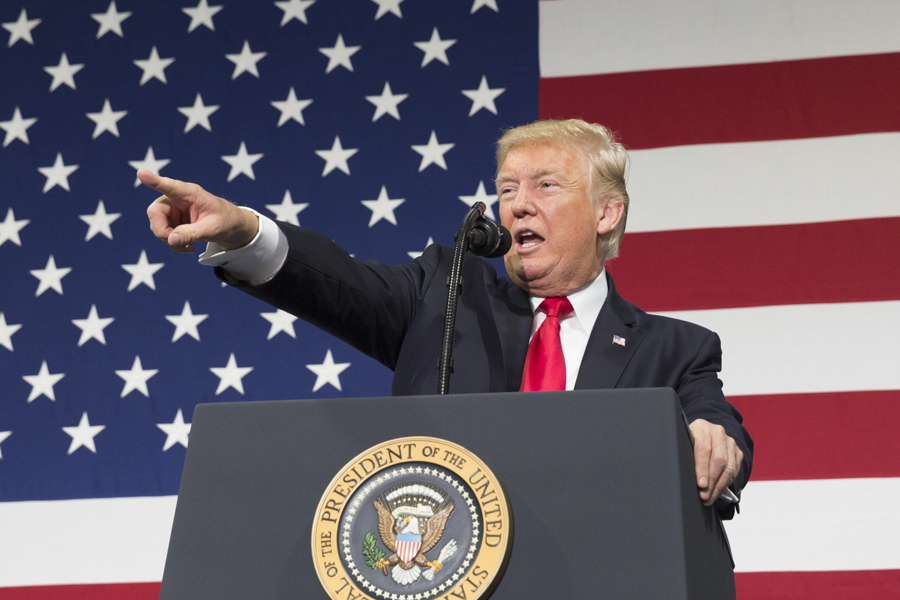
Assessing the Trump Era Economy
Eight months into the Trump presidency, the U.S. economy continues its plodding progress, although not in all the ways the president has promised. Here, we look at six economic indicators that candidate and now President Trump identified as how we should measure the success of his policies: 1) eliminating the U.S. trade deficit with the rest of the world, 2) raising real GDP growth to 3% or higher, 3) creating a net 25 million new jobs in the next decade, 4) restoring U.S. manufacturing jobs, 5) reducing the number of non-employed adult Americans, and 6) significantly raising average hourly wages.
The purpose of this exercise is to hold the president accountable for bold promises he made to the American people, even if some of those promises were ill-considered, and to explain why they may be difficult or impossible to achieve. I’ve added to each assessment that we call its “Tweetability.” This will be my judgment of how close the economic results come to what the president promised: If it meets or exceeds his promise, “Great!” If it falls short but not too seriously, we’ll call it “Neutral.” If it falls way short or takes us in the opposite direction the president promised, then “Never mind!”
Now 2/3 of the way through the first year of Trump’s presidency, the U.S. economy has maintained its steady performance, neither decelerating nor accelerating. Here is a look at each of the six performance metrics the president himself has identified as the measures of success.
The U.S. trade deficit grew slightly in July, as reported this morning by the U.S. Commerce Department. In July, the deficit in goods and services trade was $43.7 billion, up slightly from June and down from the monthly average through the first half of the year of $45.9 billion. Compared to the first seven months of 2016, the cumulative trade deficit year to date is up $28.0 billion, or almost 10%. This is a non-factor for the real economy, but a big political issue for an administration that has made eliminating the trade deficit a major policy goal. It’s a non-factor because, as most economists understand, a nation’s overall balance of trade is determined by underlying levels of savings and investment, not by the “unfair” trade policies of other nations. The United States continues to run a trade deficit with the rest of the world because the rest of the world continues to invest more in the U.S. economy than Americans invest abroad. Tweetability: Never mind!
Growth of the U.S. economy in the 2nd quarter was stronger than it first appeared, with the Commerce Department revising GDP growth upward to 3.0% on an annualized basis, according to the numbers released in late August by the U.S. Bureau of Economic Analysis. This is a significant milestone for the Trump administration, at least symbolically. President Trump and his economic team have repeatedly identified 3% growth as their goal, with the president’s FY2018 budget depending on a long-term trend of 3% to meet its 10-year targets for revenue growth and deficit reduction. President Trump was premature to read much into this. The U.S. economy achieved 3% annualized growth in five different quarters during President Obama’s second term. President Trump will have met his promise when the economy achieves 3% growth for a sustainable period spanning several years. One quarter does not constitute a change in trend. Tweetability: Neutral.
Total job growth continued at a pace in August sufficient to keep the overall unemployment rate low, but again it was nothing that would distinguish the Trump economy from the one he inherited. According to the monthly Establishment Survey numbers released last Friday by the Bureau of Labor Statistics, the U.S. economy added a net 156,000 jobs in August. While healthy, the number was well below the average job gains of 214,000 per month in the 2nd Obama term. The current pace of job growth also falls well short of the pace needed to meet President Trump’s longer-term goal of adding 25 million jobs over 10 years. Tweetability: Neutral.
The brightest facet of the Trump-era economy so far is the manufacturing sector. As candidate and now president, Trump has talked repeatedly about the need to restore the millions of manufacturing jobs that have disappeared in the past 15 years. So far in 2017, according to the same BLS employment survey, the U.S. economy has added a net 137,000 manufacturing jobs, including 36,000 in August. That’s an average monthly gain of 17,100, more than double the average gain of 8,000 during the second Obama administration. The pace falls short of what would be needed to add a million net manufacturing jobs during Trump’s first term, but it is still impressive, especially in light of the longer term trend of declining manufacturing jobs even as real manufacturing output has continue to climb. Tweetability: Great!
The unemployment rate in August continued to hover at a low rate not seen for 17 years, but that is not what President Trump has told us is the important measure. In fact, he’s dismissed the much-cited U3 rate as “totally fiction.” Instead, candidate and now President Trump has focused on the real measure of unemployment, as he sees it: those who are “not in the labor force.” These are the more than 94 million Americans in the adult, civilian, non-institutionalized population who are not employed and for various reasons are not seeking employment. The number includes those who are too discouraged to even look for work, but also those in school, disabled, at home, retired, and elderly. So far in 2017, according to the BLS household survey, also released last Friday, the ranks of the unemployed have fallen since January by 503,000, but those not in the labor have actually increased by 419,000 — from 94.4 million to 94.8 million. The share of adult Americans who are either unemployed or not in the labor force as a share of the total adult population — what the president might call the real unemployment rate — was 39.9% in August, down only a small tick from the 40.1% rate in January. Eight month’s into the Trump presidency, the standing army of non-employed adults remains virtually unchanged. Tweetability: Neutral.
Finally, the average wages paid to U.S. workers continued to rise but at a rate indistinguishable from recent years. In August, according to Friday’s BLS Establishment Survey, the average hourly wage for U.S. workers was $26.39. That’s a 2.5% increase from 12 months ago. The rate of wage growth so far in 2017 is 2.6%, only slightly better than the 2.3% annual growth in Obama’s second term. While job growth has continued apace under President Trump, it has yet to translate into significantly higher wages. Tweetability Factor: Neutral.
By President Trump’s own criteria, the U.S. economy so far under his presidency is nothing to tweet about. The one unambiguous bright spot is manufacturing employment, which the president should tout in every speech. But when it comes to real GDP growth, net job creation, reducing the vast army of non-employed, and raising average wages, the record is neutral. And when it comes to trade, the overall goods and services deficit remains larger than it was during President Obama’s second term.
